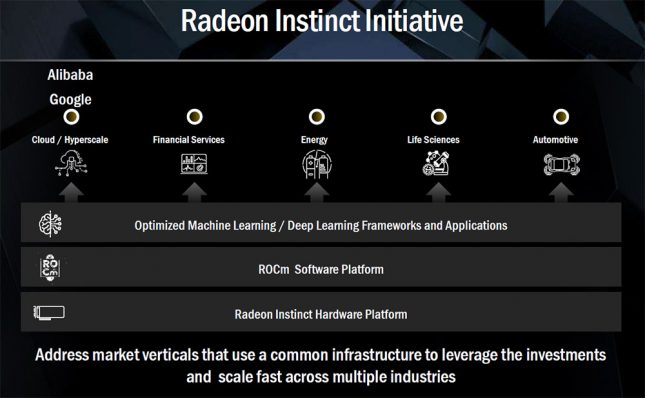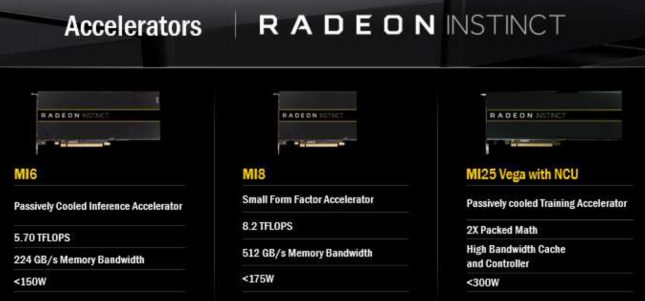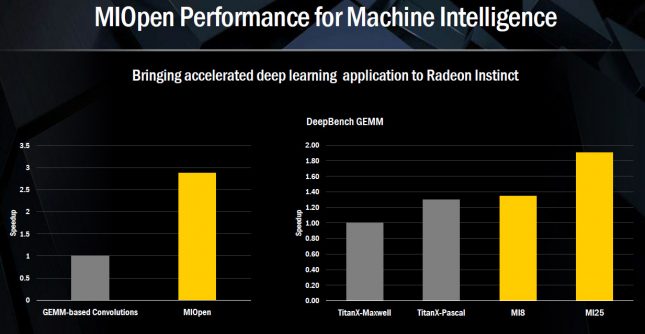AMD introduces Radeon Instinct: Accelerating Machine Intelligence
AMD introduces Radeon Instinct: Accelerating Machine Intelligence
AMD speeds deep learning inference and training with high-performance Radeon Instinct accelerators and MIOpen open-source GPU-accelerated library
SUNNYVALE, Calif. Dec. 12, 2016 AMD (NASDAQ: AMD) today unveiled its strategy to accelerate the machine intelligence era in server computing through a new suite of hardware and open-source software offerings designed to dramatically increase performance, efficiency, and ease of implementation of deep learning workloads. New Radeon Instinct accelerators will offer organizations powerful GPU-based solutions for deep learning inference and training. Along with the new hardware offerings, AMD announced MIOpen, a free, open-source library for GPU accelerators intended to enable high-performance machine intelligence implementations, and new, optimized deep learning frameworks on AMDs ROCm software to build the foundation of the next evolution of machine intelligence workloads.
Inexpensive high-capacity storage, an abundance of sensor driven data, and the exponential growth of user-generated content are driving exabytes of data globally. Recent advances in machine intelligence algorithms mapped to high-performance GPUs are enabling orders of magnitude acceleration of the processing and understanding of that data, producing insights in near real time. Radeon Instinct is a blueprint for an open software ecosystem for machine intelligence, helping to speed inference insights and algorithm training.
Radeon Instinct is set to dramatically advance the pace of machine intelligence through an approach built on high-performance GPU accelerators, and free, open-source software in MIOpen and ROCm, said AMD President and CES, Dr. Lisa Su. With the combination of our high-performance compute and graphics capabilities and the strength of our multi-generational roadmap, we are the only company with the GPU and x86 silicon expertise to address the broad needs of the datacenter and help advance the proliferation of machine intelligence.
At the AMD Technology Summit held last week, customers and partners from 1026 Labs, Inventec, SuperMicro, University of Torontos CHIME radio telescope project and Xilinx praised the launch of Radeon Instinct, discussed how theyre making use of AMDs machine intelligence and deep learning technologies today, and how they can benefit from Radeon Instinct.
Radeon Instinct accelerators will be built by AMD and feature passive cooling, AMD MultiGPU (MxGPU) hardware virtualization technology conforming with the SR-IOV (Single Root I/O Virtualization) industry standard, and 64-bit PCIe addressing with Large Base Address Register (BAR) support for multi-GPU peer-to-peer support. AMD is also investing in developing interconnect technologies that go beyond todays PCIe Gen3 standards to further performance for tomorrows machine intelligence applications. AMD is collaborating on a number of open high-performance I/O standards that support broad ecosystem server CPU architectures including X86, OpenPOWER, and ARM AArch64. AMD is a founding member of CCIX, Gen-Z and OpenCAPI working towards a future 25 Gbit/s phi-enabled accelerator and rack-level interconnects for Radeon Instinct.
Radeon Instinct accelerators are designed to address a wide-range of machine intelligence applications:
- The Radeon Instinct MI6 accelerator based on the acclaimed Polaris GPUarchitecture will be a passively cooled inference accelerator optimized for jobs/second/Joule with 5.7 TFLOPS of peak FP16 performance at 150W board power and 16GB of GPU memory
- The Radeon Instinct MI8 accelerator, harnessing the high-performance, energyefficient Fiji Nano GPU, will be a small form factor HPC and inference accelerator with 8.2 TFLOPS of peak FP16 performance at less than 175W board power and 4GB of High-Bandwidth Memory (HBM)
- The Radeon Instinct MI25 accelerator will use AMDs next-generation high performance Vega GPU architecture and is designed for deep learning training, optimized for time-to-solution
A variety of open source solutions are fueling Radeon Instinct hardware:
- MIOpen GPU-accelerated library: To help solve high-performance machine intelligence implementations, the free, open-source MIOpen GPU-accelerated library is planned to be available in Q1 2017 to provide GPU-tuned implementations for standard routines such as convolution, pooling, activation functions, normalization and tensor format
- ROCm deep learning frameworks: The ROCm platform is also now optimized for acceleration of popular deep learning frameworks, including Caffe, Torch 7, and Tensorflow*, allowing programmers to focus on training neural networks rather than low-level performance tuning through ROCms rich integrations. ROCm is intended to serve as the foundation of the next evolution of machine intelligence problem sets, with domain-specific compilers for linear algebra and tensors and an open compiler and language runtime Radeon Instinct products are expected to ship in 1H 2017. For more information, visit Radeon.com/Instinct.
Supporting Resources
- Learn more about Radeon Instinct at Radeon.com/Instinct
About AMD
For more than 45 years AMD has driven innovation in high-performance computing, graphics, and visualization technologies the building blocks for gaming, immersive platforms, and the datacenter. Hundreds of millions of consumers, leading Fortune 500 businesses, and cutting-edge scientific research facilities around the world rely on AMD technology daily to improve how they live, work, and play. AMD employees around the world are focused on building great products that push the boundaries of what is possible. For more information about how AMD is enabling today and inspiring tomorrow, visit the AMD (NASDAQ: AMD) website, blog, Facebook and Twitter pages.* Tensorflow support is expected to be available January 2017. Cautionary



